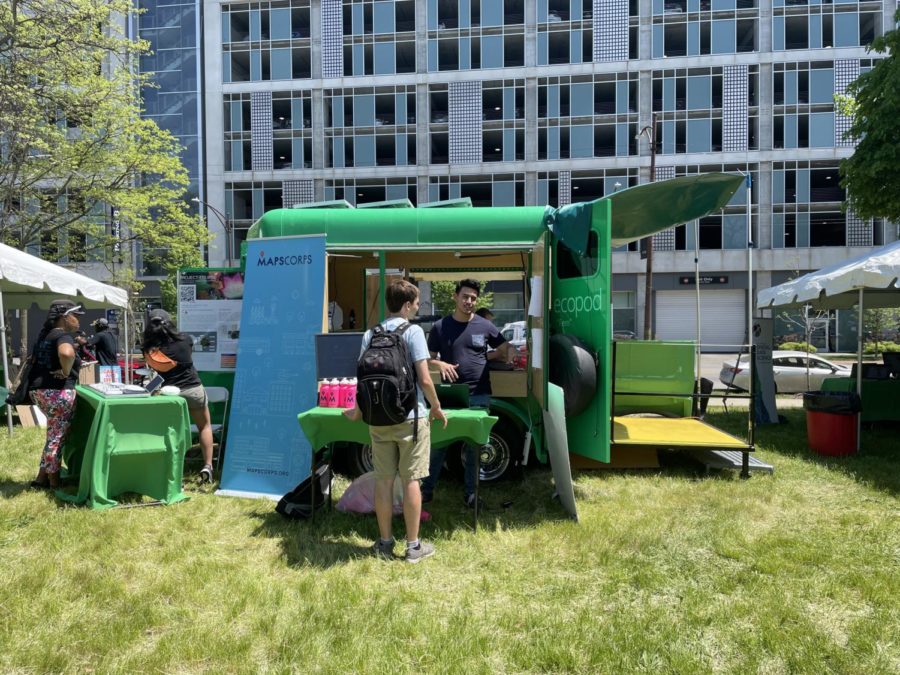A team of Microsoft researchers showcased Project Eclipse, a network of more than 100 low-cost air pollution sensors, on May 13 at Washington Park’s DuSable Museum of African American History. The project, built in collaboration with University of Chicago faculty and students, provides real-time data on air pollution and other environmental metrics through an open and accessible public website.
“Eclipse is basically a low-cost air quality monitoring network that's super hyper-local,” said Asta Roseway, the principal research designer in Microsoft’s Urban Innovation research group. More than 100 solar-powered units, scattered at bus stops throughout the city, upload their data via cellular network every five minutes.
That data includes information about four key gases—carbon monoxide, ozone, sulfur dioxide, and nitrogen dioxide—and particulate matter smaller than 2.5 microns in diameter (PM2.5). This data allows researchers and the public to assess their neighborhood air quality against the air quality index (AQI) in real time.
“This is probably one of the densest [sensor] networks in any U.S. city, and as it stands, it’s the only one that does real time,” Roseway said. “There are other sensors like…PurpleAir, but they tend to be in predominantly white neighborhoods. And they require infrastructure like Wi-Fi.” Project Eclipse’s use of cellular connectivity means the sensors rely on minimal existing infrastructure. QR codes at every Project Eclipse bus stop redirect to the project’s website.
What’s producing Chicago’s air pollutants? “Just about everything,” said Chuck Needham, one of the Urban Innovation group’s lead engineers. “Vehicles. Forest fires, campfires. Tiki torches. Deep fryers.” Tiki torches in particular—Needham stressed this point—send Project Eclipse’s air quality sensors into proverbial apoplexy. Luckily, ten months of Eclipse data now show that Chicago has relatively clean, if imperfect, air.
“Project Eclipse was designed at the outset to be rolled out in partnership with local environmental justice nonprofits so that the data would have an audience and a specific user group who could use it to build an evidence base for their work,” said Anne Dodge, executive director of the University of Chicago’s Mansueto Institute for Urban Innovation.
Microsoft offered microgrants to its nonprofit partners, paying for the time and labor invested in the project. Dodge says this kind of community integration is key. This kind of research is “not necessarily just the scientists looking at the data and coming to conclusions, but it’s the communities [being] in dialogue from the beginning and able to pose questions about the data.”
The Mansueto Institute has collaborated with the Washington-based Microsoft team for years. Christina Shaw, an undergraduate researcher with the institute, helped install and manage sensors over the past year.
In addition to sharing information about Project Eclipse, the Microsoft research event marked the second appearance of the EcoPod, a solar-powered trailer retrofitted with screens, models, and posters for public engagement. The Urban Innovation group hopes to use Eclipse and the EcoPod to bolster civic engagement with issues of climate and environmental justice. Roseway called the event a “hybrid civic engagement model” and “a way to have open, transparent conversations about tech and data.”
The event also welcomed a number of other Chicago community groups and University research teams working on issues of environmentalism. Volunteers from racial and environmental justice group Blacks in Green, along with the Field Museum and the University’s Center for Spatial Data Science, exchanged business cards and literature. Indeed, with a robust turnout at the event, the Urban Innovation group’s “hybrid civic engagement model” was in action.









